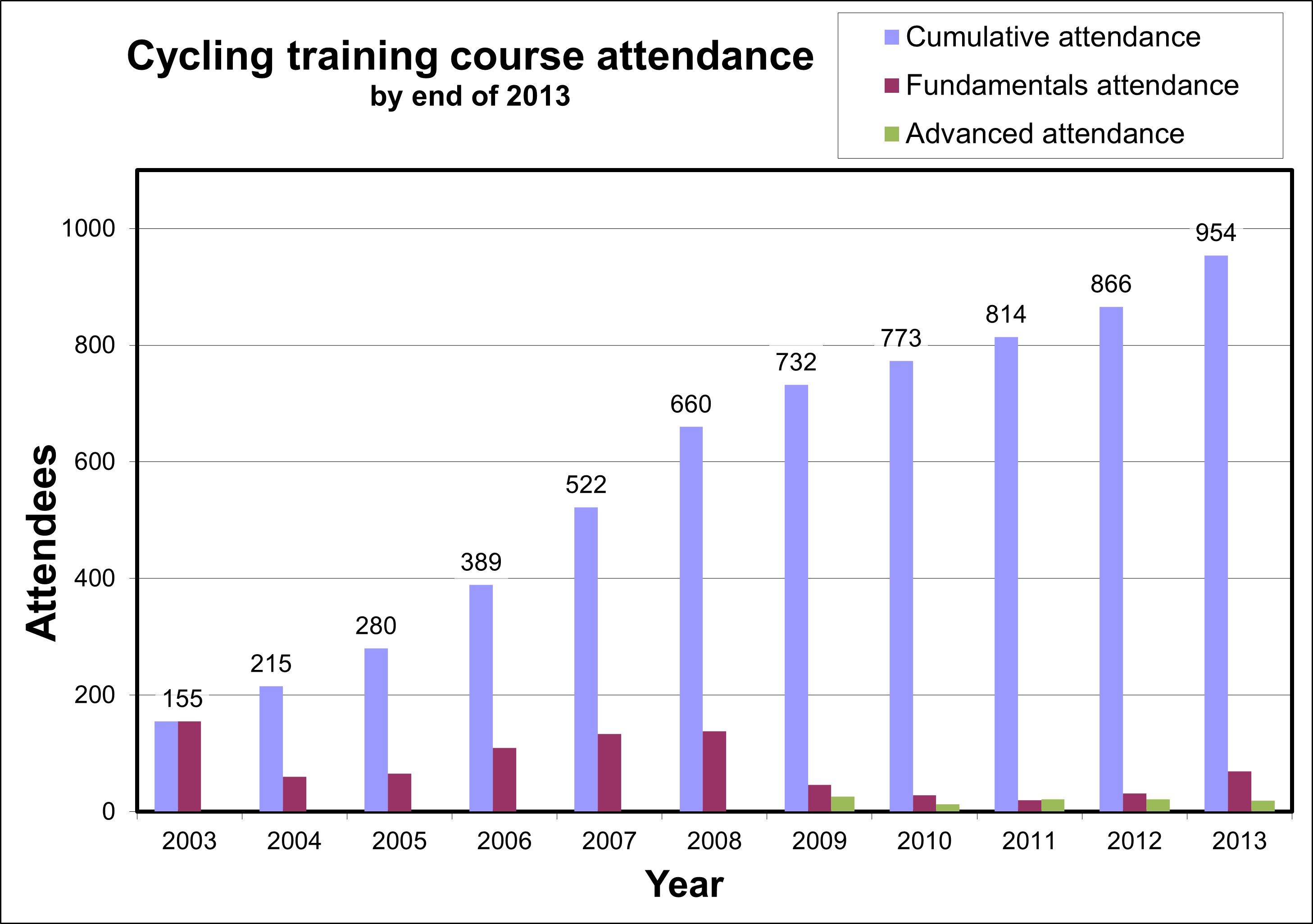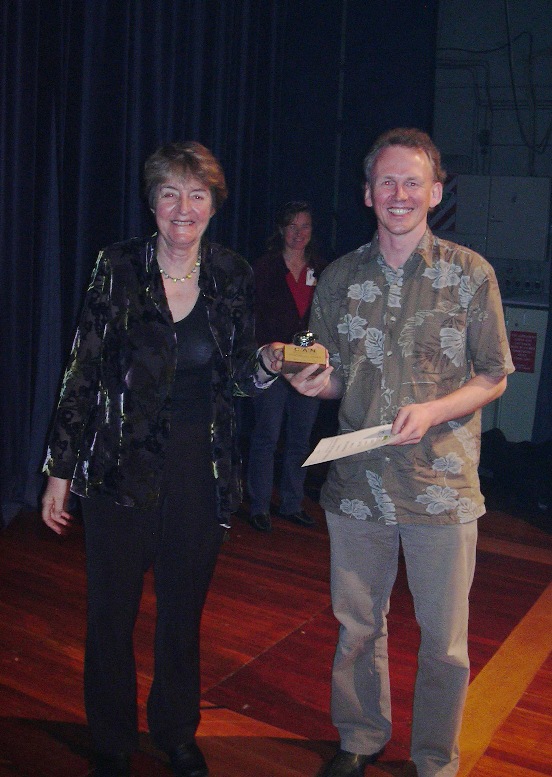10 years of Fundamentals courses
Over the last 10 years, more than 800 people have attended the training course Fundamentals of Planning and Design for Cycling. The course was first run on 3 June 2003 in Christchurch and had been taught 48 times by mid-2013, so it’s time to look back and reflect.
Beginnings
The course was first mooted by Axel Wilke in late 2000, based on the fact that there was very little knowledge about this topic in the industry, and things would presumably not change if nobody did anything about it. During Axel’s undergraduate degree at Canterbury, one 45 minute lecture concerning cycling was provided, but this session also covered walking and street lighting. So what to do?
A consortium of like-minded people was formed with Alix Newman (Axel’s colleague at Christchurch City Council who held the role of cycle planner), Glen Koorey (at the time with Opus Central Labs), and Kerry Wood (self-employed). The strategy agreed upon was that buy-in of key industry players was essential; after all, we didn’t want to start teaching, with Road Controlling Authorities or central government agencies then saying that they didn’t agree with the course content and could attendees please disregard what they had learned. To that end, a funding application was put to Transfund New Zealand for the development of the course material, because if there’s monetary commitment, it will focus everybody’s attention. Trying to get money out of Transfund proved to be a struggle, but after 18 months of persistence, funding for course material development was approved in 2002 following our second funding application.
An industry survey revealed that most demand was for a single-day training course. The four of us thus developed the course material, and this was by no means as simple as just compiling the relevant guidelines, as there was little that was agreed on for New Zealand at the time. Much of the relevant guidance was developed by us with strong input by LTSA (Land Transport Safety Authority) staff (Tim Hughes and Lyndon Hammond). We had a peer review process in place, and that involved staff from LTSA, Transfund, Transit New Zealand, and two peer reviewers from the industry: Paul Ryan (Opus Hamilton) and Roger Boulter (Hamilton City Council). The peer review culminated in a pilot course taught in June 2003, which was open to interested parties, but its main purpose was to allow all the peer reviewers and agencies to sit through the day-long training, and critique it the following day. Agency attendees included Tim Hughes (LTSA), Tony Spowart (Transit), and Gerard Burgess and possibly Ian Appleton (Transfund). The agreed changes were incorporated into the course, and a further eight courses were run in the second half of 2003.
Context
At the time, many other things were happening in New Zealand that converged to form the basis of the training course.
One issue that made the course topical were the NZ Cycling Conferences. The first one, Planning for and Promoting Cycling in Urban Areas, was the idea of Paul Ryan, who over a year and a half tirelessly built up support and sponsorship, and it was held in Hamilton’s Waikato University in 1997 over one day. Delegates said they would welcome a second one in perhaps about two years, and it was Liz Yeaman, then of EECA (Energy Efficiency and Conservation Authority), who had the idea for the second one. What prompted it was Roger Boulter’s IPENZ Transportation Group Study Award grant bid for a NZ Cycling Strategy Foundation Project, and Liz sent a letter of support, saying if successful EECA would organise a cycling conference in 2000 to showcase his draft recommendations. The Making Cycling Viable conference was held in Palmerston North in July 2000 and EECA led the organisation of this one, with support from the likes of Cycling Advocates’ Network (CAN), some local councils, and some individuals. The third conference, Transport for Living, followed a little over a year later in Christchurch in September 2001, politically initiated by senior Christchurch City councillor (now Member of Parliament) Denis O'Rourke following his attendance of the 1998 VelOZity cycling conference in Adelaide, and executed by CCC staff member Alix Newman.
It was a time when people in official governmental roles and in professional circles (notably the IPENZ Transportation Group) were realising a need to take cycling for transport more seriously. CAN had started advocating on a national level in the late 1990s, and Roger Boulter’s Cycling Strategy Foundation Project was done in 1999/2000. In 1999 there was a change of government to Labour (with Greens influence, and Sue Kedgley in particular was pushing for action on cycling, the case for this having been put to her by Wellington-based CAN members), and in 2002 the government announced its ‘Moving Forward’ package of actions (including the preparation of a Walking and Cycling Strategy on the insistence of Sue Kedgley), and the first-ever Transfund national funding for cycling was made available (up until then, cycling had not been considered a national issue and had thus not justified government funding support). It would be fair to conclude that the training course came just as there was a gap to be filled, in bringing expertise which up until then had largely resided among a few ‘keen’ professionals into the more general professional community (in particular engineers).
Other key developments in the cycling area were the development of a New Zealand Supplement to Austroads Part 14, which was circulated for comment in July 2003. The work was undertaken on behalf of Transit (who in turn were acting on behalf of the Road Controlling Authorities Forum), and was led by Andrew Macbeth, with Axel Wilke and Alix Newman having assisted him. David McGonigal was Transit’s project manager. The LTSA was working on the Cycle Network and Route Planning Guide (CNRPG), with a first draft issued just prior to the October 2003 NZ Cycling Conference held on the North Shore, and the final version published in 2004. Tim Hughes led the work, assisted by Paul Ryan.
Course delivery
The course development team had the objective of increasing the knowledge of the industry about all matters concerning cycling. As many of us interact with advocates, we formulated the secondary objective of wanting to upskill advocates as well, so that they can benefit from the knowledge improvement at the same time, but also learn about the constraints that the industry has to work within. Since 2009, we have also had a two-day Advanced Planning and Design for Cycling course, reflecting the desire of many in the industry to learn more beyond the basics.
1.jpg)
Until the end of 2005, we had course registrations and venue bookings administered by the New Plymouth-based NZIHT. They were reluctant to accommodate volunteer advocates at reduced rates, and in 2006, BikeNZ’s advocacy manager Stephen Knight took on the administrative task. Since late 2006, the courses have been administered by Axel’s company (the first two courses by Traffix; then by the successor company ViaStrada). By mid-2013, the Fundamentals course has been taught a grand total of 48 times, with another 10 Advanced courses. The figure below gives a breakdown on course attendance over the years. The most regular presenters have been Axel Wilke (36 courses), Glen Koorey (22 courses), and Andrew Macbeth (21 courses). Andrew returned to New Zealand from Canada after the consortium had started the course development work, and he was thus not part of the development team, which he very much regretted. In 2006, we ran a less technical half-day version of the course for decision-makers, but there was not much demand for this initiative.

The course material has changed significantly over the years. When the pilot course material is compared with the latest PowerPoint slides, a huge amount of change can be observed. The sets of 2003 and 2014 presentations are online – have a look for yourself.
Whilst keeping the material up to date is time-consuming, it is imperative that it is relevant to attendees and reflects the change in best practice that naturally occurs over time. Course evaluation results have been kept since 2007, and overall the course is rated highly by attendees.
Impact
So what is the relevance of the course? For a start, it has resulted in interested parties sitting down and defining guidelines applicable to New Zealand. It won the ‘Best Cycling Promotion’ category at the 2005 Cycle Friendly Awards, held as part of the 5th New Zealand Cycling Conference (see figure below). The course has become part of the engineering curriculum at Canterbury University at Masters level (Roger Boulter also presented it twice at Auckland University), and there’s hence a much better chance of graduates entering the industry having some basic knowledge. Tim Hughes (these days with NZTA) remarked several years ago that when he travels through New Zealand, he can see the “basic skills taught in this training course being applied to an increasing number of projects”. The cycling course in fact inspired the NZTA to develop a similar Fundamentals course for walking, which was first offered in 2008.
Over the ten years, have we achieved everything that we wanted to achieve? We are not sure that we have yet attracted ‘mainstream roading engineers’ to attend. This particularly applies to those who have been in the industry for many decades and who may feel that they have a good handle on traffic matters in general. But if they weren’t ever formally trained in providing for cycling, it might be difficult for them to get out of automatic ‘roading’ mode. We may have got better at providing specialist cycling facilities, but we are not sure if we’ve got much better at providing for cycling in general on our existing roads and intersections (where an upgrade may actually make things worse for cycling). This is something to ponder going forward.



